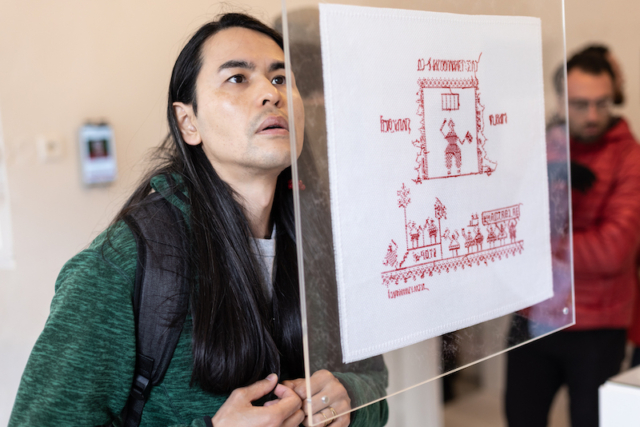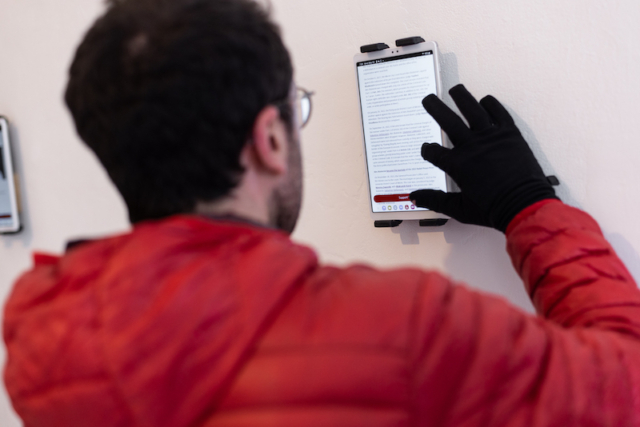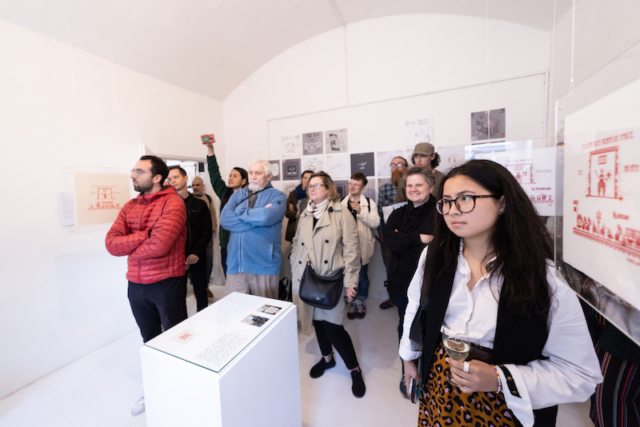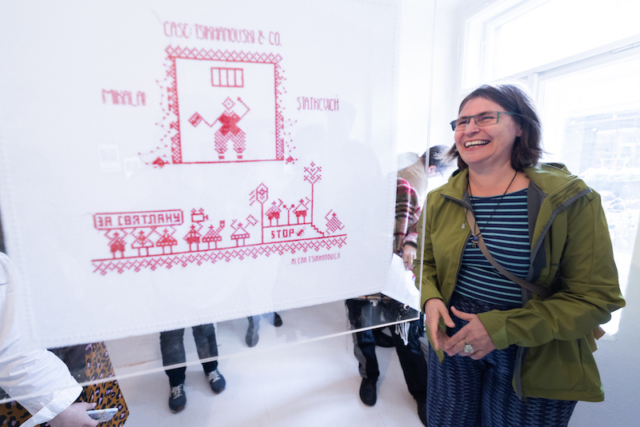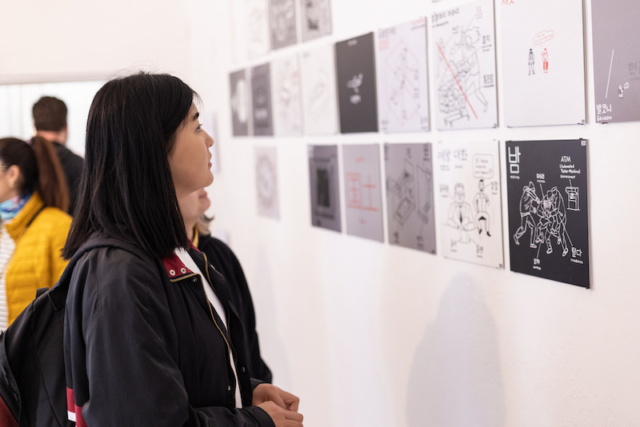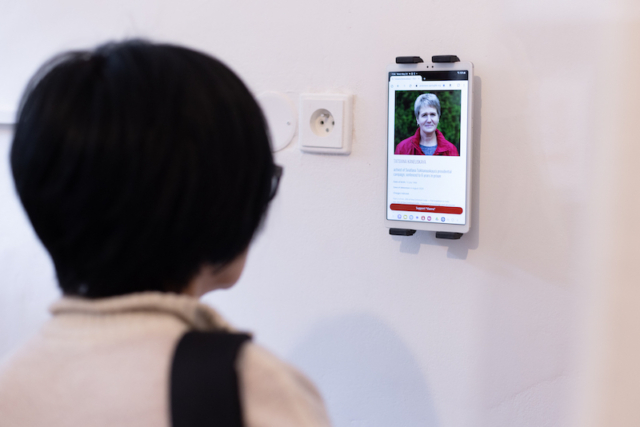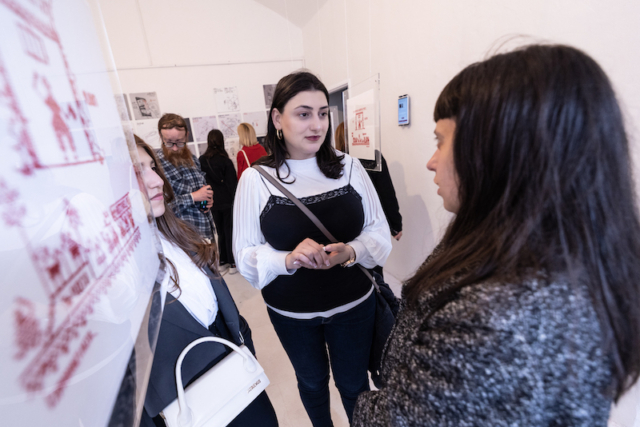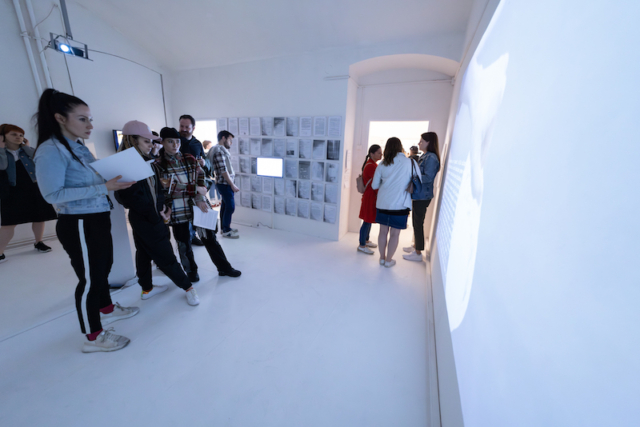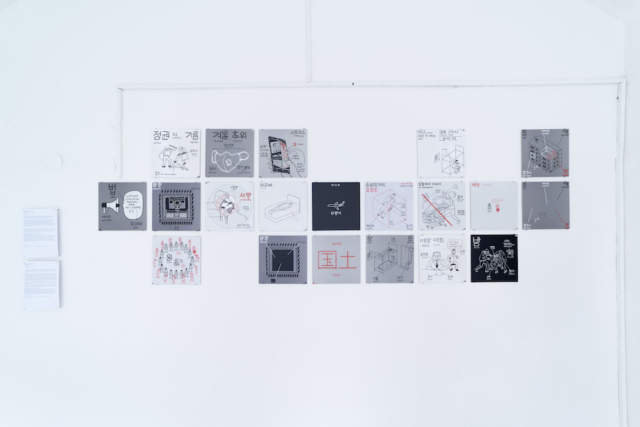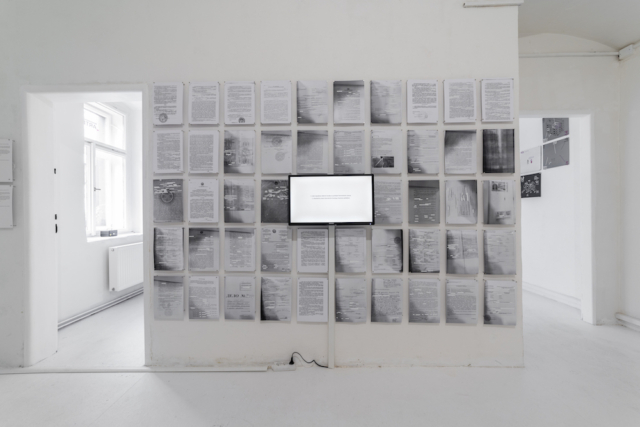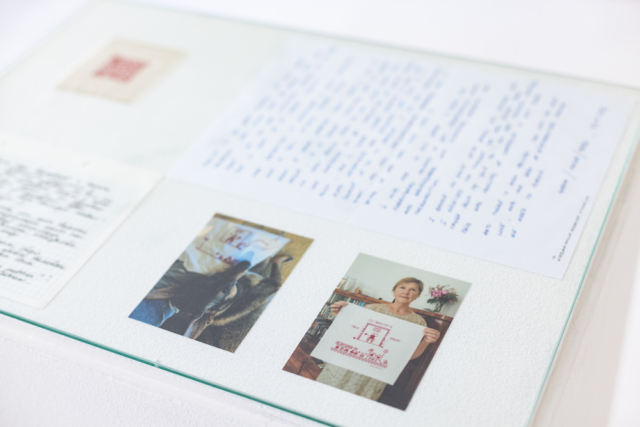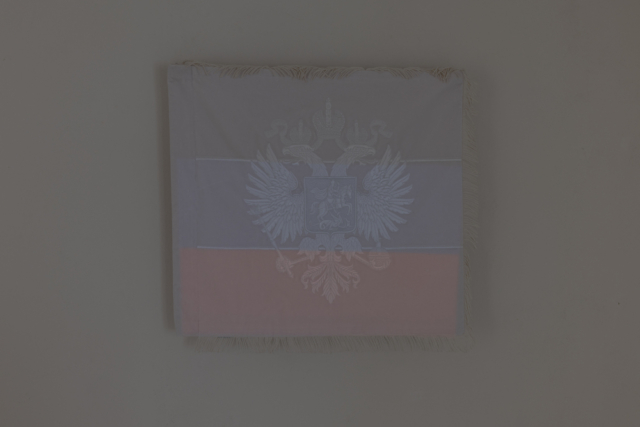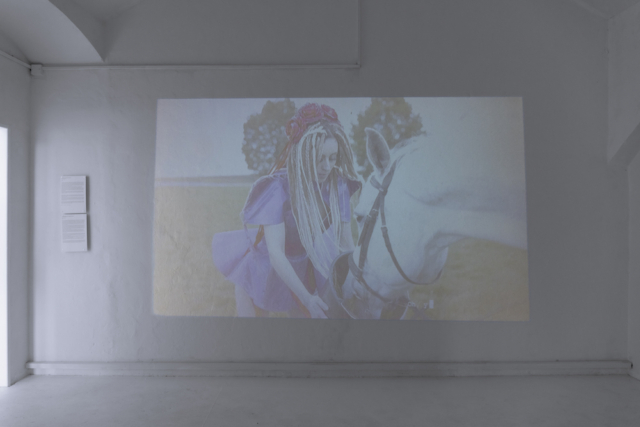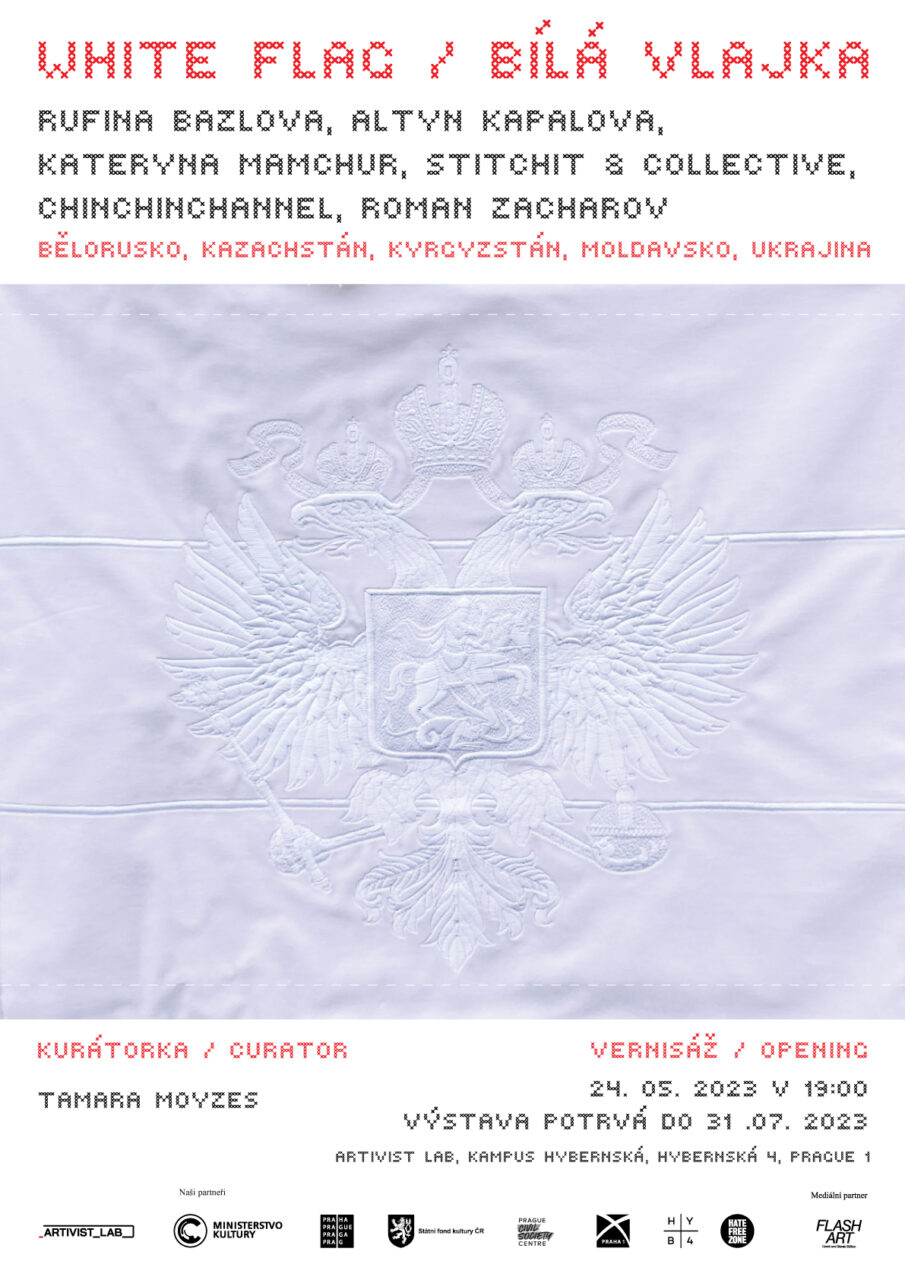Umělci: Rufina Bazlova, Kateryna Mamchur, Altyn Kapalova, Roman Zacharov, Stitchit a Kolektiv, ChinChinChannel
Kyrgyzstán, Kazachstán, Ukrajina, Bělorusko, Moldavsko
Výstava “Bílá vlajka“ nabízí různorodé reflexe ruské koloniální politiky prostřednictvím umění. Umělci divákovi poskytují platformu pro zkoumání a kritiku dopadu ruské koloniální politiky v různých regionech. Výstava se věnuje složitým historickým příběhům a osvětluje často přehlížené nebo marginalizované aspekty ruského kolonialismu, snaží se pochopit složitý vztah mezi uměleckou reflexí koloniálního dědictví v dnešní společnosti a odpovědět na otázku, zda se “svoboda uměleckého projevu” stala všude a rovnocenně měřítkem fungování demokracie. Snaží se také porozumět složitému vztahu mezi uměním a svobodou v současných společnostech. Východiskem je fakt, že po 2 sv. válce se ratifikoval zákon svobody slova a dodal se k němu dodatek „svobody uměleckého projevu“, který se stal určitým měřítkem funkčnosti demokracie nejen v Evropě.
A proto demokratické společnosti považují uměleckou tvorbu za zvláštní formu lidské činnosti a uměleckou svobodu za zasluhující si protektivní zacházení. Nicméně, když je umělecká svoboda testována přes zákonný filtr, umění už nemá tak privilegovaný režim.
Státy mohou podporovat nebo omezovat uměleckou svobodu.
Na to, jak jednoduše se nejen z umělce může stát politický vězeň, poukazují na výstavě tři díla: V první řadě je to projekt nazvaný #Framed in Belarus umělecké skupiny „Stitchit a Kolektiv“, kterou v roce 2021 založily vizuální umělkyně Rufina Bazlova (Bělorusko) a kurátorka Sofia Tocar (Moldavsko). Jedná se o obsáhlý sociální umělecký projekt věnovaný politickým vězňům v Bělorusku. Počet oficiálně uznaných politických vězňů v Bělorusku v současné době dosahuje více než 1 400 osob. Cílem projektu je vytvořit portréty každého nezákonně odsouzeného občana tradiční běloruskou technikou výšivky červenou nití na bílém pozadí, a zaznamenat tak významnou epochu běloruských dějin lidovým kódem – ornamentem.
Dílo #SHALAkoreanwithroman od umělce a aktivisti Roman Zacharova (Kazachstán) začalo jako deník na Instagramu, kde se snaží propojit výuku korejštiny a zároveň zaznamenávat společenský a politický život v Kazachstánu. Zacharov má korejské kořeny, jeho prarodiče z matčiny strany byli do Kazachstánu deportováni z ruského Dálného východu v období sovětské politiky nuceného přesídlování národů koncem 30. let 20. století. Má tedy korejské kořeny, ale narodil se v Kazachstánu a vyrostl na ruském jazyce. Název této práce mnohé vysvětluje, ve slově #SHALAkoreanwithroman – předpona „shala“ je kazašské slovo označující špatnou znalost rodného jazyka, obecně to znamená – nevhodné. Navzdory skutečnosti, že Kazachstán je nezávislý již více než 30 let, mnoho Kazachů je „šala“, tedy nejsou řádnými Kazachy, Korejci nebo Čečenci atd. Celé generace vyrostly bez znalosti svého rodného jazyka a kultury. A teprve teď se snaží s velkým zájmem poznávat sebe, svůj jazyk a kulturu, proces sebeidentifikace je v běhu.
Sám Roman Zacharov byl však v roce 2019 odsouzen jako umělec ke správní pokutě za chuligánství, kde ve skutečnosti jen vyvěsil na most ve veřejném prostoru transparent s ústavním zněním: „Jediným zdrojem státní moci je lid“. Na snímcích z každodenního života, které v galerii Artivist Lab představujeme, dokumentuje nejen aktuální události, ale i tak důležité věci, jako jsou politika úřadů a porušování práv a svobod občana v zemi.
Instalace od umělkyně a aktivistky Altyn Kapalové (Kyrgyzstán) nazvané „JMÉNO MATKY NENÍ ZLOČIN“ poukazuje nahluboce zakořeněné patriarchální postoje a rostoucí náboženský fundamentalismus. Ale také přetrvávající rusifikaci kyrgyzské společnosti a s tím spojené zavedení jmen po otci coby povinné oficiální součásti identity. Altyn tak bojuje s byrokracií založenou na dvojité patriarchálnosti: kyrgyzské a ruské. Kapalova v instalaci vystavuje 50 oskenovaných A4 ze svého soudního procesu. Většinu těchto dokumentů sama umělkyně ani nevlastní, nacházejí se na Nejvyšším kyrgyzském soudu. Stát totiž umělkyni obžaloval za to, že požádala oficiálně o změnu jmen pro její tři děti.
Ve svém videoartu nazvaném “Ukrajinská renesance: Jazyk intimity” umělkyně Kateryna Mamchur (Ukrajina) zdůrazňuje téma dekolonizace Ukrajiny prizmatem užívání ukrajinského jazyka v intimních chvílích jako způsobu zachování a udržení kulturního dědictví a identity Ukrajiny.
Není žádným tajemstvím, že v důsledku násilné rusifikace, zejména v sovětské éře, je dnes část ukrajinského obyvatelstva ruskojazyčná, zatímco druhá část mluví ukrajinsky.
Myšlenka uměleckého projektu byla založena na využití umělé inteligence, tj. s využitím komunikace s ChatGPT na téma kolonizace a dekolonizace zemí postsovětského prostoru, zejména dekolonizace Ukrajiny. Fragmenty této komunikace se staly základem předmluvy, telepatického dialogu mezi umělou inteligencí Junonou, (ztvárněnou samotnou umělkyní) a Koněm.
Umělkyně použila úryvky básně “Aeneida” od Ivana Kotljarevského, v díle jsou také použity texty z “Kateřiny” od ukrajinského básníka Tarase Ševčenka a písně soromického folklóru. Mamchur studovala práce ukrajinské etnografky Iryny Ihnatenko, která zkoumá společnost, etnikum, zvyky a religiozitu Ukrajinců včetně metafor jejich intimního života. Mamchur se ve svém díle vrací nejen symbolicky k ukrajinským tradicím, kultuře a folklóru. Je také důležité poznamenat, že toto dílo bylo přímo vytvořeno pro výstavu „Bílá vlajka“.
Dalším dílem je trailer běloruské umělecké a aktivistické skupiny nazvaný „ChinChins se zbláznili.“ ChinChin Chanelpublikuje krátké satirické skeče reagující na aktuální události a propagandistická prohlášení, je to velmi populární mediální startup skupiny divadelníků, režisérů a scenáristů, který pracuje s politickou satirou a byl spuštěn na YouTube v Bělorusku v srpnu 2020. ChinChin využívá kombinaci divadla a digitálních médií k rozkrývání propagandy a promlouvá k publiku o citlivých tématech, jako jsou válka, korupce, absurdita státem sponzorovaných médií a lži úředníků.
Instalace „Bílá prezidentská standarta. Bílá hymna“ od umělkyně Rufiny Bazlové se stala inspirací k samotnému názvu výstavy „Bílá vlajka“, ale i k jej vizualizaci. Bílá vlajka je symbol oznámení, kapitulace a ukončení válečného konfliktu. Bazlova však na vlajku promítá známé barvy, které se objevují, ale vzápětí za zvuku a šumu zase symbolicky mizí.
Výstava “Bílá vlajka“ reprezentuje novou generaci umělců a myslitelů, která odmítá být součástí ustanovených pravidel ekonomického trhu a státních autorit.
Namísto toho vytváří nové radikální metody angažování. V roku 2010 byla tato forma umění nazvaná, (mimo jiné) „Artivism”. Umělecký aktivizmus neznamená vytvářet politické umění o problému, ale chce přímo problém, na který poukazuje, změnit. Má umělecký aktivizmus potenciál vést ke společenským změnám?Jde o změny sociální, společenské, kulturní, legislativní či institucionální? Je možné tyto změny, či dopady uměleckých akcí měřit? Na tyto otázky hledá výstava odpověď.
Kurátorka: Tamara Moyzes
Na podzim roku 2018 jsem v Kyjevě facilitovala tvorbu strategie pro místní pobočku mezinárodní organi-zace. Bylo to čtyři roky po Euromajdanu, jehož výsledkem bylo svržení proruského prezidenta Janukovyče a jasné změně orientace Ukrajiny na Západ. Čtyři roky po anexi Krymu a čtyři roky poté, co se ozbrojení separatisté podporovaní Ruskem zmocnili vládních budov a vyhlásili tak zvanou Doněckou a Luhanskou republiku nezávislými státy. Někteří kolegové a kolegyně na naší akci v Kyjevě byli vnitřní vysídlenci právě z této oblasti. Byly to čtyři roky poté, kdy Ruskem kontrolované jednotky sestřelily nad východní Ukrajinou letadlo MH17, během kterého zahynula posádka i všichni cestující, včetně mé kamarádky.
Po dvou dnech workshopů a produktivních diskusí se kolegové shodli na strategických cílech. Zarazil mě název jednoho – „dekolonizace“. Přiznávám, že jsem byla zmatená. Tento pojem ve mně evokoval podobně jako u většiny lidí na Západě osvobozenecké boje v Africe a Asii za vymanění se z evropské nadvlády. Nechápala jsem, jak to souvisí s Ukrajinou, a kolegy jsem tlačila, aby se zaměřili na důležitější otázky jako je demokratizace, prosazování lidskoprávních standardů a posilování občanské společnosti. Nemohla jsem být dál od pravdy! „Dekolonizace“ z jejich hlediska znamenala osvobození se od dlouhého období ruské, respek-tive sovětské nadvlády. A právě tato emancipace a nezávislost je nezbytná pro další úspěšný rozvoj Ukrajiny. Jak prosté. Tento osobní příběh ilustruje, jak se u lidí na Západě v průběhu času vyvíjelo chápání situace
v Ukrajině. Již tehdy se ozývaly hlasy poukazující na to, že Rusko nikdy neprošlo procesem reflexe expan-zivní imperiální politiky zaměřené na rozsáhlé oblasti obklopující jeho území. Jejich argumenty však nebyly brány v potaz. Rovněž mnozí západní politici vědomě ignorovali skutečnost, že po rozpadu Sovětského svazu si Rusko udrželo svůj ekonomický a vojenský vliv v zemích tzv. „blízkého sousedství“ a že nikdy nedalo neet-nickým Rusům žijícím v zemi možnost sebeurčení. Nejkřiklavějším příkladem potlačování ambicí za nezá-vislost je Čečensko.
Západ měl tendenci až do invaze Ruska do Ukrajiny pohlížet na země za svou východní hranicí skrze prizma imperiálního centra – Moskvy. „Dekolonizace Ruska“ se na Západě stala módním pojmem teprve po 24. únoru 2022. Ve východní Evropě, na Kavkaze a ve Střední Asii však začal proces emancipace mno-hem dříve a neomezuje se pouze na vzrůstající preferenci používání vlastních jazyků místo ruštiny, polemiky o tom, komu ruština patří, a kritické přehodnocování národních dějin a kultury. Lidé žijící v regionu se učí komunikovat mezi sebou nikoliv optikou Ruska, ale prostřednictvím vlastních identit. To samozřejmě není ani snadné, ani prosto hrozeb: kde leží hranice mezi národní identitou a nacionalismem? Jak dosáhnout plné suverenity bez posilování „tradičních“ konzervativních a patriarchálních hodnot?
Dekolonizace má v různých zemích různou dynamiku a závisí na mnoha vnitřních i vnějších faktorech. Jedná se o dlouhodobý proces, do něhož se musí zapojit nejen kolonie, ale také kolonizátor: budoucí předsta-vitelé Ruska (ať už to bude kdokoli) i širší ruská společnost budou muset projít poctivou reflexí.
Výstava „Bílá vlajka“ představuje jeden z krůčků v rámci procesu dekolonizace: prostřednictvím umělecké-ho projevu se noří do složitých historických příběhů a osvětluje mnohdy přehlížené nebo marginalizované aspekty ruského kolonialismu.
Text Dáša van der Horst
Dáša van der Horst působí v Prague Civil Society Centre. Tato organizace se zaměřuje na podporu občanské společnosti v zemích Východní Evropy, Kavkazu a Střední Asie.
Vernisáž 24. 05. 2023 zahajuje občanský summit nazvaný „Unlock“ který je zaměřený na nejnovější trendy na pomezí aktivizmu, médií a technologií ve východní Evropě a střední Asii, který se uskuteční v Praze 25.-26. května 2023, a je organizovaný Prague Civil Society Centre.
Výstava vznikla v spolupráci s Prague Civil Society Centre
Partneři: MKČR, MHMP, SFK, Praha 1, Prague Civil Society, Kampus Hybernská
Foto: Josef Rabara
white flag
Artists: Rufina Bazlova, Kateryna Mamchur, Altyn Kapalova, Roman Zacharov, Stitchit a Kolektiv, ChinChinChannel
Kyrgyzstan, Kazakhstan, Ukraine, Belarus, Moldova
The exhibition “The White Flag” offers a variety of reflections on Russian colonial policy through art. The artists provide a platform for audiences to explore and critically examine the impact of Russian colonial practices in different regions. Exploring complex historical narratives and bringing to light often ignored or marginalized aspects of Russian colonialism, the exhibition seeks to understand the complex relationship between artistic reflection on colonial legacies in contemporary society and to answer the question of whether ‘freedom of artistic expression’ has become an equal measure of the functioning of democracy everywhere. It also seeks to understand the complex relationship between art and freedom in modern societies. The starting point is the ratification of the Freedom of Expression Act after the Second World War, the amendment of which has made ‘freedom of artistic expression’ a measure of the functioning of democracy not only in Europe.
That is why democratic societies regard creative work as a special form of human activity and artistic freedom as worthy of protection. However, when artistic freedom is examined through a legal filter, art no longer enjoys such preferential treatment. States can support or restrict artistic freedom.
Three works in the exhibition show how easily an artist can become a political prisoner: First, the project #Framed in Belarus by the art group “Stitchit a Kolektiv”, founded in 2021 by visual artist Rufina Bazlova (Belarus) and curator Sofia Tocar (Moldova), is a large-scale social art project dedicated to political prisoners in Belarus. The number of officially recognised political prisoners in Belarus currently stands at over 1,400. The aim of the project is to create portraits of each illegally convicted citizen using the traditional Belarusian technique of embroidery with red thread on a white background, thus recording an important epoch in Belarusian history with a folk code – ornament.
Artist and activist Roman Zakharov’s (Kazakhstan) work #SHALAkoreanwithroman originally began as an Instagram diary, attempting to combine teaching Korean with documenting social and political life in Kazakhstan. Zakharov has Korean roots, as his maternal grandparents were deported from the Russian Far East to Kazakhstan during the Soviet policy of forced resettlement in the late 1930s. He, therefore, has Korean roots, but was born in Kazakhstan and grew up speaking Russian. The title of the work explains much, in the word #SHALAkoreanwithroman – the prefix “shala” is a Kazakh word indicating poor knowledge of the mother tongue, and generally means – inappropriate. Despite the fact that Kazakhstan has been independent for over 30 years, many Kazakhs are “shala”, i.e. not proper Kazakhs, Koreans, Chechens, etc. Whole generations have grown up without knowing their mother tongue and culture. Only now, with great interest, are they trying to get to know themselves, their language, and their culture, and the process of self-identification is underway.
However, Roman Zakharov himself, as an artist, was sentenced to a fine for hooliganism in 2019, when in fact he had simply hung a banner on a bridge in a public place with the constitutional text “The people are the only source of state power”. In the images of everyday life that we present in the Artivist Lab gallery, he documents not only current events but also such important issues as the policies of the authorities and the violation of the rights and freedoms of citizens in the country.
An installation by artist and activist Altyn Kapalova (Kyrgyzstan) entitled “MOTHER’S NAME IS NOT A CRIME” highlights deeply rooted patriarchal beliefs and growing religious fundamentalism. But also the ongoing Russification of Kyrgyz society and the introduction of patronymics as a compulsory official part of identity. Altyn is thus fighting a bureaucracy based on dual patriarchy: Kyrgyz and Russian. In the installation, Kapalova displays 50 A4 scans from her case. Most of these documents are not even in the artist’s possession; they are at the Kyrgyz Supreme Court. In fact, the state charged the artist with officially requesting a name change for her three children.
In her video art entitled “Ukrainian Renaissance: the Language of Intimacy“, artist Kateryna Mamchur (Ukraine) highlights the issue of Ukrainian decolonisation through the lens of using the Ukrainian language in intimate moments as a way to preserve and maintain Ukraine’s cultural heritage and identity.
It is no secret that as a result of forced Russification, especially during the Soviet era, part of the Ukrainian population is now Russian-speaking, while the other part speaks Ukrainian.
The idea of the art project was based on the use of artificial intelligence, i.e. using ChatGPT communication on the topic of colonisation and decolonisation of the countries of the post-Soviet space, especially the decolonisation of Ukraine. Fragments of this communication became the basis of the prologue, a telepathic dialogue between the artificial intelligence Junona (portrayed by the artist herself) and the horse.
The artist has used fragments of the poem “Aeneid” by Ivan Kotlyarevsky, the work also uses texts from “Catherine” by Ukrainian poet Taras Shevchenko and songs of Soromian folklore. Mamchur has studied the work of Ukrainian ethnographer Iryna Ihnatenko, who explores the society, ethnicity, customs and religiosity of Ukrainians, including metaphors of their intimate lives. In her work, Mamchur revisits Ukrainian traditions, culture and folklore, not only symbolically. It is also important to note that this work was created specifically for „The White Flag“ exhibition.
Another piece is a trailer by a Belarusian art and activist group called “ChinChins go nuts“. ChinChin Chanel, which publishes short satirical sketches responding to current events and propaganda statements, is a very popular media startup by a group of theatre artists, directors, and writers working with political satire, launched on YouTube in Belarus in August 2020. ChinChin uses a combination of theatre and digital media to expose propaganda and talk to audiences about sensitive issues such as war, corruption, the absurdity of state-sponsored media, and the lies of officials.
The installation “White Presidential Standard. The White Anthem‘ by artist Rufina Bazlová was the inspiration for the title of the exhibition ‘The White Flag’, as well as for its visualisation. The white flag is a symbol of the announcement, surrender, and end of a war conflict. Bazlova, however, projects familiar colours onto the flag, which appear and then symbolically disappear with sound and noise.
The exhibition “White Flag” represents a new generation of artists and intellectuals who refuse to be part of the established rules of the economic market and state authorities.
Instead, they are creating new radical methods of engagement. In 2010, this art form has been called (among other things) “Artivism”. Artistic activism is not about making political art about an issue, but about directly changing the issue it addresses. Does artistic activism have the potential for social change? Is it social, societal, cultural, legislative, or institutional change? Can these changes or the impact of artistic action be measured? The exhibition aims to answer these questions.
Curator: Tamara Moyzes
In the autumn of 2018, I was in Kyiv facilitating a strategic session in a local branch of an internation- al non-governmental organisation. This was four years after the Euromaidan, which resulted in the ousting of pro-Russian president Viktor Yanukovych in a clear demonstration of Ukraine’s orientation toward the West. It was four years after the annexation of Crimea and four years after armed Russian-backed separatists had seized Ukrainian government buildings and declared the so-called “Donetsk” and “Luhansk” republics as independent states. Some of my colleagues attending the session in Kyiv were internally displaced people from that region. It was four years after Russian-controlled forces had shot down MH17, killing all of the crew and passengers, among them one of my friends.
After two days of workshops and productive discussions, my colleagues agreed on a set of strategic directions. It struck me that one of them was called “decolonization”. At the time, I admit, I was baffled. As for most people in the West, the word “decolonisation” brought to my mind the liberation struggles in Africa and Asia to break free of European domination. I didn’t see how this was relevant to Ukraine, and suggested to my colleagues that they should focus more on the critical issues related to the democratization of the country, enforcing human rights, and strengthening civil society.
How wrong I was! My colleagues explained to me that “decolonization” meant freeing society from the long period of Russian/Soviet domination. And that exactly this emancipation and independence is necessary for the successful continuation of development in Ukraine. What an eye opener.
This personal story illustrates how the understanding of the situation in Ukraine by ordinary people in the West evolves over time. There were already some voices pointing out that Russia had never gone through the process of reflecting on its imperial relationship to the vast area surrounding its territory, but their arguments were overlooked. Also, many politicians in the West chose to ignore the fact that after the breakup of the Soviet Union, Russia kept its economic and military influence in the countries of the so-called “close neighborhood”, and that it never gave the non-ethnic Russians living within its borders the chance to determine their future. The most flagrant example of Russia’s suppression of the independence ambition is Chechnya. Until the full-scale invasion of Ukraine by Russia, the tendency of the West was to look at the countries to the East by way of the imperial centre, Moscow. Decolonizing Russia became a buzz word in the West only from February 24, 2022. In Eastern Europe, the Caucasus and Central Asia however, the emancipation process started much earlier and is not limited only to the increased preference for native languages over Russian, polemics about who owns the Russian language, and critical re-examinations of national histories and cultures. People living in the region learn to communicate across borders not through the fractured lens of Russia, but by referencing their own identities. Naturally, this is neither easy, nor without dangers: where is the border between national identity and nationalism? How can full sovereignty be achieved without entrenching conservative and patriarchal values? Decolonization will have different dynamics in different countries and is dependent on many internal and external factors. It is a process that will take time. And this process must include not only the colonized but also the colonizer: honest reflection by future Russian leaders (whoever they will be) and the broader Russian society must happen.
The exhibition “The White Flag” is another small step in this decolonization process: through a diverse range of artistic expressions, it delves into complex historical narratives, shedding light on the often overlooked or marginalized aspects of Russian colonialism.
Text by Dáša van der Horst
Dáša van der Horst works at the Prague Civil Society Centre. This organization focuses on supporting civil society in the countries of Eastern Europe, the Caucasus and Central Asia.
The event on 24 May 2023 will open the civil society summit “Unlock”, which will focus on the latest trends at the intersection of activism, media and technology in Eastern Europe and Central Asia and will take place in Prague on 25-26 May 2023, organised by the Prague Civil Society Centre.
The exhibition was produced in cooperation with the Prague Civil Society Centre.
Partners: MKČR, MHMP, SFK, Praha 1, Prague Civil Society, Kampus Hybernská

